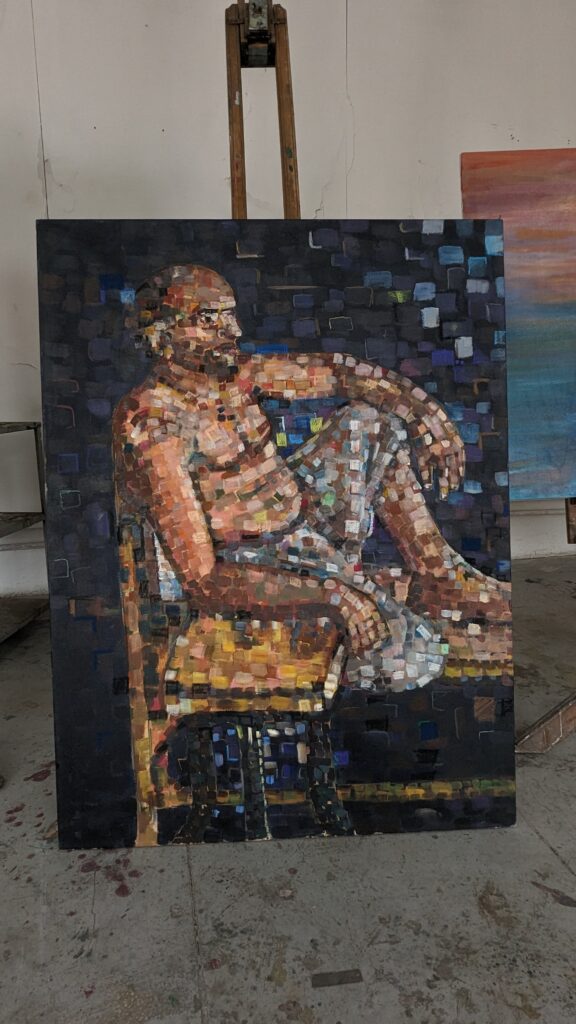About the Author- Maham Ajmal
I am doing my bachelor’s in Fine Arts from the National College of Arts, Lahore. As a Fine Artist, I have dedicated my life to the captivating world of visual art. Painting is my passion and I love drawing too. I love exploring all mediums but I prefer oils more. My passion lies in creating evocative and thought-provoking pieces that resonate with both the heart and the mind.
Exploring My World of Visual Art
My art is a journey of exploration, an expression of creativity, and an invitation to see the world through a different lens. Through the medium of paint, I strive to convey emotions, stories, and unique perspectives, inviting viewers to immerse themselves in the rich tapestry of my imagination.
I am so excited to share my art journey which I started recently, my recent painting ‘Purple Scape’ is inspired by the streets of Tokyo Japan. I am a fine artist I love exploring all mediums but I specifically prefer oil paints so this painting is all from oils.

Color is the language I use to convey emotions and stories in my art. For “purple scape” I carefully selected a palette of purples and ethereal blues. These colors would become the foundation of the piece.
I added a layer of acrylic as my base color for the background. This painting is inspired by the streets of Tokyo a world full of hassle and neon lights where tradition meets innovation.
Imagine standing at a bustling street corner in Tokyo. People rush by, each with a story, a purpose. The city never sleeps, and in my painting, I wanted to capture this constant motion, the rhythm of life that defines Tokyo.
I’m currently working on a series of paintings that explore some live figure exploration and emotion. Each piece combines vibrant colors and intricate details to convey a sense of wonder and connection to the people around us. It’s been an inspiring journey, and I can’t wait to share the finished works with you soon! Connect with me on social media to keep in touch with the upcoming works!

This painting, “New Life”, is a live figure. I painted a person’s life, but I was inspired by mosaic-style work (Pompeii). I painted in an impressionist way, giving an effect of pixels. I used different tones of the same colours to give depth to the figure. The techniques I used were very bold; I just applied paint strokes without any fear or hesitation. I am sharing some of my recent works.
Describing your visual art to your audience effectively is essential for helping them understand and appreciate your work. You have seen how I depicted story behind my work. Describing visual artwork is a skill that involves conveying the essence, details, and emotional impact of the piece to your audience. Whether you’re writing an art critique, an exhibition review, or simply sharing your thoughts on a piece of art, here’s my guidance on how to describe visual artwork effectively:
Start with a clear Title:
Begin by giving your artwork a title that provides a hint or context about the piece. This can give your audience a starting point for understanding your work.
Define your medium:
Specify the materials and techniques you used to create the artwork. Whether it’s oil on canvas, watercolor, or any other medium, this information helps your audience appreciate the technical aspects of your work.
Share your inspiration:
Describe what inspired you to create this particular piece of art. Discuss any themes, emotions, or ideas you aimed to convey through your work. Sharing the story behind your art can create a deeper connection with your audience.
Explain your process:
Provide insights into your creative process. Discuss how you approached the composition, color choices, and any unique techniques you used. This helps your audience understand the craftsmanship behind your art.
Discuss symbolism and meaning:
If your artwork contains symbolism or deeper meaning, explain it to your audience. Describe the symbolism of specific elements, colors, or motifs in your art and how they contribute to the overall message or narrative.
Share your emotions:
Art often conveys emotions. Describe the emotions you felt while creating the piece and the emotions you hope the audience will experience when viewing it.
Talk about style and influences:
Mention any artistic styles or movements that influenced your work. Discuss any artists or artworks that inspired you or that you admire. This can help your audience place your work in a broader artistic context.
Use descriptive language:
Use vivid and evocative language to describe your art. Paint a verbal picture that captures the essence of your work, including its mood, texture, and atmosphere.
Keep it concise and engaging:
While providing information is important, avoid overwhelming your audience with too many details. Keep your descriptions concise and engaging, leaving room for interpretation and exploration.
Visual aids:
If you’re presenting your art in a gallery or online, consider including high-quality images of your work to accompany your descriptions. Visual aids can help your audience connect more deeply with your art.
Practice and refine:
Practice describing your art to different audiences, and be open to feedback. Refine your descriptions over time to make them more compelling and accessible.
Remember that not everyone will have the same level of art knowledge, so strive for a balance between providing insights and allowing room for individual interpretation. Ultimately, the goal is to enhance your audience’s appreciation of your visual art and create a meaningful connection between your work and those who view it. It’s essential to communicate your observations and emotional responses clearly while respecting the diversity of perspectives and interpretations in the world of art.
Let’s connect on social media! Join me on Instagram to explore more of my work!
